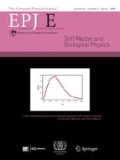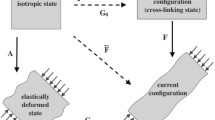Abstract:
We examine the robustness of order in nematic elastomers under mechanical strains imposed along and perpendicularly to the director when director rotation is prohibited. In contrast to electric and magnetic fields applied to conventional nematics, mechanical fields are shown theoretically and experimentally to greatly affect the degree of nematic order and related quantities. Unlike in liquid nematics, one can impose fields perpendicular to the director, thereby inducing biaxial order which should be susceptible to experimental detection. Nematic elastomers with unchanging director and degree of order should theoretically have the same elastic moduli for longitudinal and transverse extensions. This is violated when nematic order is permitted to relax in response to strains. Near the transition we predict the longitudinal modulus to be smaller than the transverse modulus; at lower temperatures the converse is true, with a crossover a few degrees below the transition. The differences are ascribed to the different temperature dependence of the stiffness of uniaxial and biaxial order. We synthesised side chain single-crystal nematic polymer networks, performed DSC, X-ray, birefringence, and thermo-mechanical characterisations, and then obtained linear moduli from stress-strain measurements.
Similar content being viewed by others
Author information
Authors and Affiliations
Additional information
Received 29 September 2000
Rights and permissions
About this article
Cite this article
Finkelmann, H., Greve, A. & Warner, M. The elastic anisotropy of nematic elastomers. Eur. Phys. J. E 5, 281–293 (2001). https://doi.org/10.1007/s101890170060
Issue Date:
DOI: https://doi.org/10.1007/s101890170060




